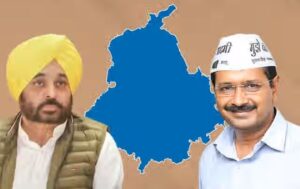 When the Aam Aadmi Party (AAP) swept into power in Punjab, it came on the promise of real change, honesty, and development. People believed that AAP would free the state from corruption and political exploitation. But reality has unfolded differently. Punjab today is not being governed by its own leaders—it is being controlled from Delhi. Arvind Kejriwal and his team are accused of running Punjab as a colony of Delhi, with the Chief Minister reduced to a puppet.
When the Aam Aadmi Party (AAP) swept into power in Punjab, it came on the promise of real change, honesty, and development. People believed that AAP would free the state from corruption and political exploitation. But reality has unfolded differently. Punjab today is not being governed by its own leaders—it is being controlled from Delhi. Arvind Kejriwal and his team are accused of running Punjab as a colony of Delhi, with the Chief Minister reduced to a puppet.
Punjab elected a Chief Minister, but the perception among citizens is that he does not hold real authority. Every important decision—from appointments to policies—is dictated by the Delhi high command. This has created a dangerous imbalance where the state’s elected leadership is seen as powerless, and the voice of Punjabis is muffled under Kejriwal’s command. For a proud state like Punjab, this is nothing short of humiliation.
The devastating floods exposed the hollowness of governance. While people drowned in misery, the leadership was busy arranging photo sessions and publicity stunts. Delhi’s interference delayed the release of funds and resources, while the administration in Punjab looked directionless. Villagers trapped in water for days received sympathy in front of cameras, but little genuine help. This is how political control from Delhi has failed the people in their darkest hour.
Farmers, the lifeline of Punjab, had high hopes from AAP. They expected relief from debt, fair prices for crops, and policies to protect their livelihoods. Instead, their demands have been sidelined. Delhi’s political strategies take precedence, while Punjab’s farmers are left with empty promises. The same farmers who fought for survival during the agitation against farm laws are now watching their own government ignore their plight.
Rising crime, drug trafficking, and targeted killings have shaken Punjab’s sense of security. Instead of empowering Punjab Police and restoring discipline, Delhi’s influence has demoralized the force. Law and order decisions are politicized, and criminals exploit the weak system. The people now feel unsafe in their own state, while their leaders remain more interested in pleasing their bosses in Delhi.
AAP often boasts about its “Delhi model” of schools and hospitals. But in Punjab, this model is more slogan than substance. Schools still suffer from lack of teachers and infrastructure. Hospitals are understaffed and underfunded. Instead of designing policies for Punjab’s rural realities, Delhi’s leadership is busy forcing propaganda projects to claim success. The result is that ordinary people see no real improvement in basic services.
The harsh truth is that AAP does not view Punjab as a priority—it sees it as a stepping stone for its national ambitions. Every decision, every announcement, is made with the goal of expanding influence in other states. Punjab has become a testing ground for Delhi’s political experiments. The people who voted for change are now left feeling used, ignored, and betrayed.
Punjab has a proud history of struggle, sacrifice, and resilience. It cannot afford to be treated as a political playground. The state needs leadership that rises from its own soil and puts Punjab first, not leaders who take instructions from Delhi. Unless this grip is broken, Punjab will continue to slide into deeper crises, and AAP’s Delhi leadership will be remembered not as saviors, but as destroyers of Punjab’s future.
Skip to content
Punjab Top New